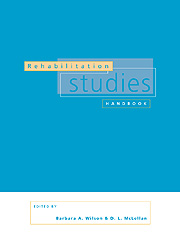Book contents
- Frontmatter
- Contents
- List of contributors
- 1 Introduction to rehabilitation
- 2 Disabled people in society
- 3 Disability equality training
- 4 Towards a therapeutic alliance model of rehabilitation
- 5 Rehabilitation education: a learner-centred approach
- 6 Work, occupation and disability
- 7 Management in rehabilitation
- 8 Research and evaluation in rehabilitation
- 9 Statistical methods
- 10 Social policy, disability and rehabilitation
- 11 Principles of the acquisition of sensorimotor skills
- 12 Management of acquired cognitive disorders
- 13 Challenging behaviour: helping people with severe brain damage
- 14 Pain
- 15 The multiply handicapped child
- 16 The transition to adult life
- 17 Factors specific to disabled elderly people
- Index
5 - Rehabilitation education: a learner-centred approach
Published online by Cambridge University Press: 06 November 2009
- Frontmatter
- Contents
- List of contributors
- 1 Introduction to rehabilitation
- 2 Disabled people in society
- 3 Disability equality training
- 4 Towards a therapeutic alliance model of rehabilitation
- 5 Rehabilitation education: a learner-centred approach
- 6 Work, occupation and disability
- 7 Management in rehabilitation
- 8 Research and evaluation in rehabilitation
- 9 Statistical methods
- 10 Social policy, disability and rehabilitation
- 11 Principles of the acquisition of sensorimotor skills
- 12 Management of acquired cognitive disorders
- 13 Challenging behaviour: helping people with severe brain damage
- 14 Pain
- 15 The multiply handicapped child
- 16 The transition to adult life
- 17 Factors specific to disabled elderly people
- Index
Summary
Introduction
This chapter focuses on rehabilitation education and explores the application to it of learner-centred principles. It is primarily directed towards people engaged in the education of health professionals about rehabilitation both in their preregistration or postregistration training. It is hoped too that the concepts outlined here could also be applied to the education of people with disability, their relatives and their non-professional carers. The essential message being conveyed is that the principles of learner-centred education are generalisable.
Learner-centred and teacher-centred education
Studies in which the behaviour of teachers and learners were carefully observed have provided valuable insights into the process of education. Learnercentred education occurs when a teacher helps a learner achieve some educational objectives agreed between them which address both the teacher's and the learner's agendas. Teacher-centred education on the other hand occurs when teachers merely inform learners about what they think they ought to know. The most fundamental way in which these two educational approaches differ then is this: in learner-centred education the teacher helps the learner to learn, whereas in teacher-centred education teachers pass on what they know to learners. Learner-centred education involves learners identifying for themselves the gaps in their knowledge, whereas teacher-centred education assumes gaps are there, and sets out to fill them. In learner-centred education the learner is active. In teacher-centred education the learner is passive. Learner-centred education is concerned with helping learners direct their own learning. Teacher-centred eduction, on the other hand, is concerned with directing what learners should learn, and often how they should learn it. In learner-centred education the learners are encouraged to evaluate their own performance, whereas in teacher-centred education the teacher is the learner's assessor.
- Type
- Chapter
- Information
- Rehabilitation Studies Handbook , pp. 95 - 114Publisher: Cambridge University PressPrint publication year: 1997



